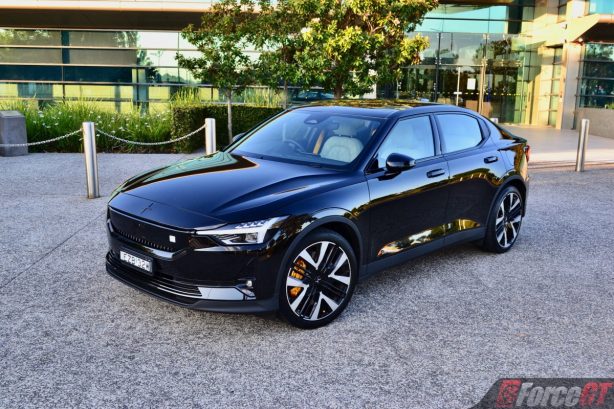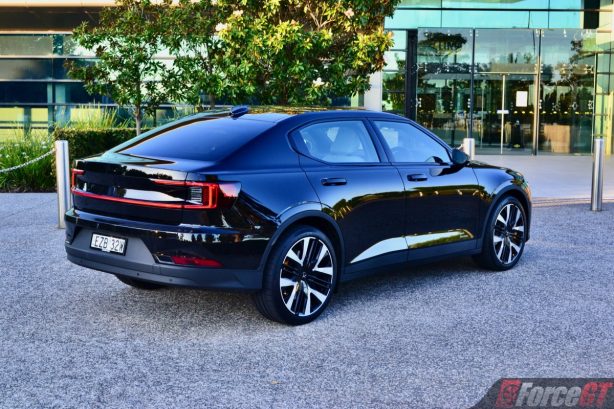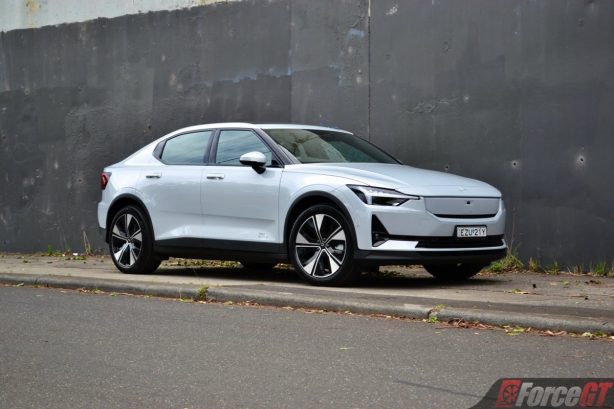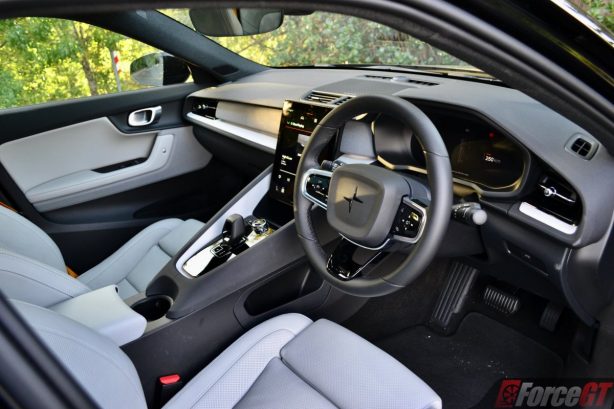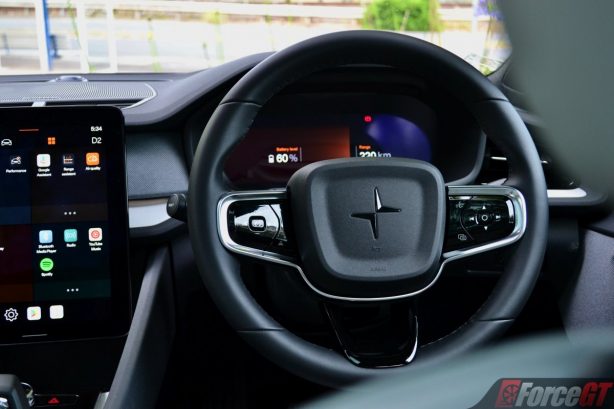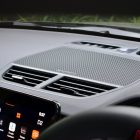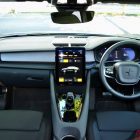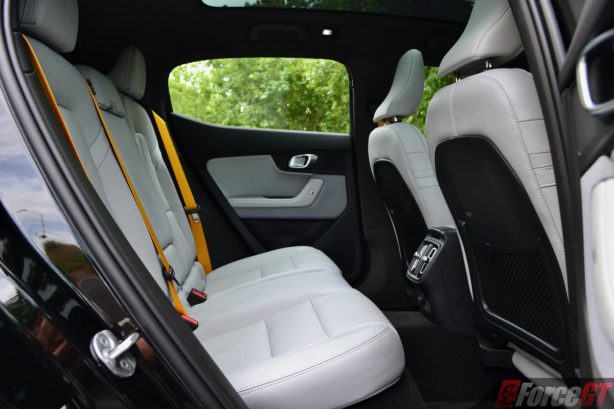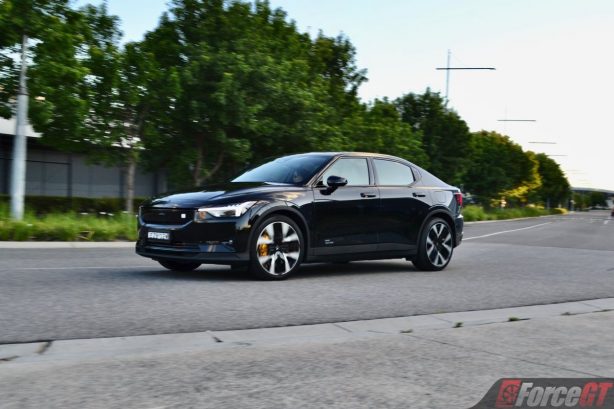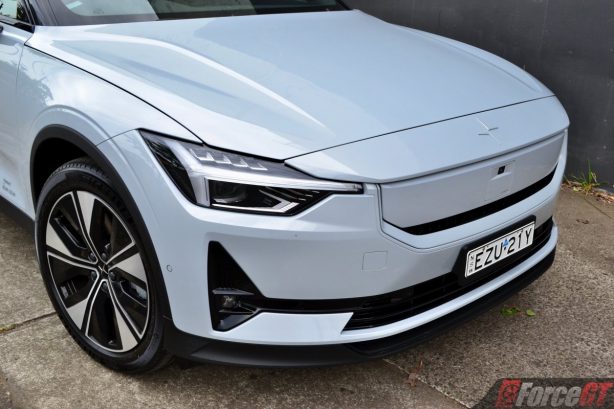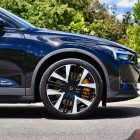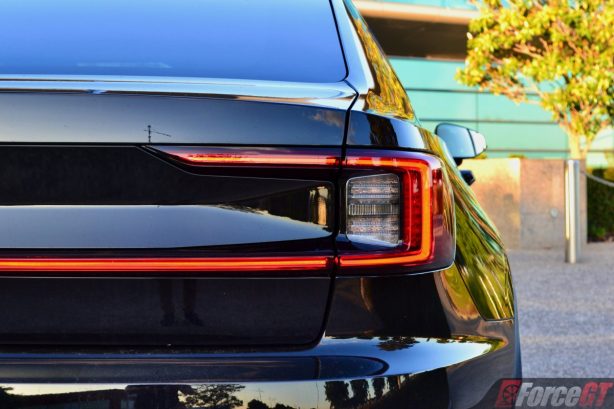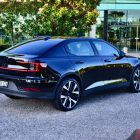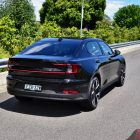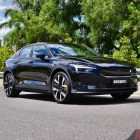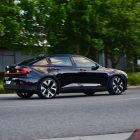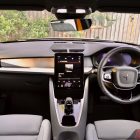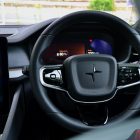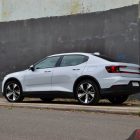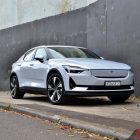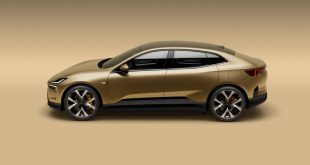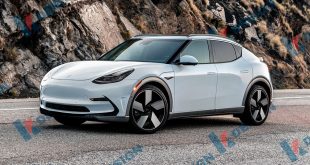Polestar, the Scandinavian EV brand that’s been hot on the trail of Tesla, has upped the competition with an updated Polestar 2. The rival to the Tesla Model 3 can now travel up to 22% further, consume up to 9% less energy and charge up to 34% faster, at least on paper. It’s not a big claim though, as the revised model gets a host of hardware upgrades including larger batteries and new electric motors.
The good news is that, despite the improvements, there’s no price increase across the range. Kicking off the range is the Standard Range Single Motor variant priced at $67,400. Moving up, the Long Range Single Motor model costs $71,400, while the Long Range Dual Motor all-wheel drive flagship asks $76,400. The latter can be optioned up with a $9,000 Performance Pack which brings more power and quicker acceleration. All prices exclude on-road costs.
For comparison, the Tesla Model 3 Standard Range Single Motor costs $61,900 and the Dual Motor Long Range all-wheel drive is priced at $71,900. The Model 3 Performance hero is now no longer offered. This means the revised Model 3 line-up is about $5,000 cheaper than the Polestar 2 for equivalent variants.
Is the premium in price for a Polestar 2 justified? It’s subjective but here’s our take. In terms of looks, the ForceGT team is split with some preferring the curvy, elegant lines of the Tesla Model 3 while others like the contemporary and European styling of the Polestar 2. But almost all of us agree that the Polestar 2 has a richer and more complete interior. When it comes to driving dynamics, we all give it to Polestar.
Our testers for this review were the Polestar 2 Long Range Single Motor and Long Range Dual Motor with Performance Pack. From the outset, these revised models look no different to the pre-updated versions, except for a new cover for the grille – which Polestar calls “Smartzone” for its embedded sensory gizmos – and mild styling tweak on the 20-inch wheels in the LRDM Performance. It’s the right move, as there’s no need to mess with the clean, minimalist and understated styling of the car. It’s a smart looking sedan with intricate detailing like the Thor’s Hammer daytime running lights, frameless door mirrors and rear LED light blade.
The plastic cladding on the wheel arches is an acquired taste and there’s a bit too much wheel gap for our liking, but the wheel design is striking with the wheels themselves sitting nicely flush with the fenders. Opting for the Performance Pack on the LRDM model will see the brake callipers tucked behind those massive 20-inch rollers painted in Swedish gold – Polestar’s trademark accent – and boy do they look good.
The Polestar 2 has a relatively square passenger cell with a flat roofline and that’s intended. The cabin is roomier as a result of this design, with space for five adults to stretch out and plenty of headroom for rear passengers. However, there’s a rather large centre hump in the rear footwell which is surprising given the lack of a driveshaft (being an EV).
As previously mentioned, the Polestar 2’s interior design is a winner. The vibe is calm, futuristic and premium, with delicate details in the mix of bold trim pieces. The brand hasn’t gone overly obsessed with LCD screens either like most other EV manufacturers. The 11.2-inch portrait centre touchscreen is large but not crazily massive, with it neatly integrated into the dashboard at a perfect angle for top notch ergonomics. A modest digital instrumentation panel sits under a conventional binnacle, viewed through a sporty three-spoke steering wheel. The raised centre console houses one of the coolest shifters we have seen. Shaped like something out of Star Trek, the shifter has an illuminated Polestar logo at the base which is such a neat touch. Look up at the roof and another Polestar logo is visible near the rear view mirror, this one projected on to the panoramic glass roof – nice.
All these translate to unique cockpit feel from behind the wheel, one that is sporty, sophisticated and driver focused. Mixed in with the glass roof, the interior is also bright and inviting, though it can get pretty hot in summer with the amount of light the roof lets in. The air-con is slow to cool things down, which means on hot sunny days the car is best parked in the shade.
A plethora of storage spaces are dotted around the cabin, including large door pockets, a covered compartment under the front central armrest, storage pockets on either sides of the centre console and a pair of cup holders for the front and rear. There’s not one but two boots – a 405-litre main rear boot, expandable to 1,095 litres with the rear seats folded and a second 35-litre boot under the bonnet.
Standard equipment in the Polestar 2 has been revised to increase overall value. Driver Awareness features are now standard, including Blind Spot Information System (BLIS) with steering support, Cross Traffic Alert with brake support, and Rear Collision Warning and Mitigation, along with the 360-degree surround view camera and automatic dimming exterior mirrors. A wireless phone charger is now also standard on all versions.
But the biggest update is to the powertrain. More advanced electric motors and inverters are fitted to all variants, bringing vastly improved range and performance across the board. Previously front-wheel driven, single-motor variants are now rear-wheel driven for a sportier driving feel. Power is upped substantially from 170kW to 220kW – a hike of 50kW, while torque has increased to 490Nm from 330Nm, that’s a jump of 160Nm! The 0-100 km/h sprint time has been slashed by as much as 1.2 seconds, down to 6.2 seconds.
Dual motor variants are now rear-drive bias thanks to a revised drivetrain setup that sees the rear motor as the primary drive source. The front motor can now be disengaged completely to support efficiency gains, with it only coupled when more power or traction is needed. The dash to 100km/h is 0.2 second quicker than before at 4.5 seconds.
Available to purchase as a downloadable over-the-air software upgrade for any eligible Long Range Dual Motor variants, the optional Performance Pack lifts power to 350kW while keeping torque figures the same. The 40kW of extra power is enough to trim the 0-100km/h sprint time to 4.2 seconds.
Regardless of single or dual motor variants, the Polestar 2 has no fuss laying its power down on to the tarmac. Despite the high power and torque output, there’s virtually zero wheel spin at launch, even for rear-wheel drive models. Being an EV, power delivery is completely linear from the get go. Plant your foot down at any speed and the instantaneous torque thrust the car forward for super quick overtaking.
With most of the weight from the battery and drivetrain stuffed low in the car, the centre of gravity is low resulting in a relatively flat cornering stance. The steering is numb but otherwise precise and smooth. The brakes are strong but slightly wooden when one pedal drive is turned off.
While both variants on test exhibited good ride comfort with just enough firmness for a sporty driving feel, the Long Range Single Motor model felt like the better daily driver as its lighter, nimbler and has a more relaxing demeanour. Its thicker tyre wall also absorbs road imperfections better.
All Polestar 2 versions feature upgraded lithium-ion batteries which are capable of faster charging rate. Long range battery supports up to 205 kW DC fast charging, while standard range battery is good for up to 135 kW DC.
AC charging is also possible via a standard home AC wall plug, or 11kW or 22kW public charge points. Charging at home can take a full day or more for a full charge, which is painfully slow. So, it’s always better to charge at a charging bay, which can top up around 100km in about 15 minutes at 22kW AC. We also charged at 50kW DC which topped the battery up from near empty to 80 percent in about 30 minutes.
For paid public charging, the fee at the time of writing is around $0.40 per kWh. This means generally you’ll be able to run the Polestar 2 at a lower cost than most petrol or diesel powered vehicle.
The Standard Range Single motor version now has a range of up to 532km WLTP, an increase of 54km, and the Long Range Single Motor variant can now achieve 654km WLTP, an increase of 103km.
The front motor disconnect function on the Long Range Dual Motor variant is particularly effective at maximising range, which is now rated at 591km WLTP, a big increase of 104km from before.
The Polestar 2 is covered by a five-year, unlimited kilometre warranty. More impressive, it’s also offered with five-year free servicing and roadside assistance.
Verdict
Design & Comfort
Performance & Handling
Quality
Economy
Equipment & Features
OUR SCORE
4.2/5
+ Plus
- Cool, contemporary design
- Premium feel interior
- Rear-wheel drive adds sporting flavour
- Substantial increase in range
– Minus
- $8.6k to unlock Performance Pack via software upgrade?
- Glass roof cabin gets very hot in summer
Overall
We haven’t seen an update this significant from a manufacturer for a long while. Rather than merely cosmetics and specification tweaks, Polestar has gone the length of upgrading where it matters the most. The improved motors and batteries plus a host of other new hardware deliver higher performance and greater range to the Polestar 2 – quite significantly in models like the Long Range Single Motor and Long Range Dual Motor. While the rest of the vehicle has mostly stayed the same in this update, the Polestar 2 remains one of the coolest EVs around. And the Tesla Model 3 has never faced a greater challenge.
2024 Polestar 2 Pricing and Specification
| Price (excl. on-road cost): | From: $67,400 Standard range Single motor: $67,400 Long range Single motor: $71,400 (tested) Long range Dual motor: $76,400 Long range Dual motor with Performance Pack: $85,400 (tested) |
| Warranty | 5 years / unlimited km |
| Warranty Customer Assistance | 5 years roadside assist |
| Country of Origin | Sweden; manufactured in China |
| Powertrain | Standard range Single motor: 200kW/490Nm Long range Single motor: 220kW/490Nm Long range Dual motor: 310kW/740Nm Long range Dual motor with Performance Pack: 350kW/740Nm |
| Drivetrain | Rear/All-wheel drive |
| 0-100km/h (seconds): | Standard range Single motor: 6.4 Long range Single motor: 6.2 Long range Dual motor: 4.5 Long range Dual motor with Performance Pack: 4.2 |
| Range (WLTP, km): | Standard range Single motor: 532 Long range Single motor: 654 Long range Dual motor: 591 Long range Dual motor with Performance Pack: 591 |
| Body | 5-door liftback, 5-seats |
| Safety | 5-star ANCAP, 6 airbags, ABS, EBD, BA, VSC, Automatic Emergency Braking (AEB), blind spot monitoring system, lane keeping assist, speed limit sign recognition, reversing camera with 360-degree view |
| Dimensions (L/W/H/W-B) mm | 4,606/1,891/1,477/2,735 |
| Entertainment | 11.2-inch touchstreen infotainment system, satellite navigation, Bluetooth, USB, AM/FM/DAB, 8-speaker stereo |
 ForceGT.com Car News, Car Reviews, Video Reviews, Tuning and much more.
ForceGT.com Car News, Car Reviews, Video Reviews, Tuning and much more. 